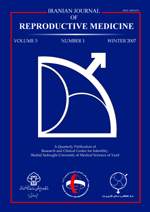
|
International Journal of Reproductive BioMedicine
Research and Clinical Center for Infertility, Shahid Sadoughi University of Medical Sciences of Yazd
ISSN: 1680-6433
EISSN: 1680-6433
Vol. 5, No. 3, 2007, pp. 109-115
|
 Bioline Code: rm07024
Bioline Code: rm07024
Full paper language: English
Document type: Research Article
Document available free of charge
|
|
|
International Journal of Reproductive BioMedicine, Vol. 5, No. 3, 2007, pp. 109-115
| en |
Colony formation ability of frozen thawed spermatogonial stem cell from adult mouse
Koruji, Morteza; Movahedin, Mansoureh; Mowla,Seyed Javad & Gourabi, Hamid
Abstract
Background: The basis of spermatogenesis is the spermatogonial stem cells (SSCs). The concentration of SSCs is very small. However, a system that supports the proliferation and maintenance of SSCs in vitro could be used to preserve and expand SSCs numbers as well as increase success in transplantation. It is a new avenue to restore spermatogenesis in azoospermia subjects.
Objective: Proliferation and enhancement of frozen-thawed SSCs numbers during in vitro culture.
Materials and Methods: Both Sertoli and spermatogonial cells were isolated from adult mouse testes. Frozen-thawed spermatogonial cells were cultured in two groups: simple culture (Experimental 1) and co culture with Sertoli cells (Experimental 2). Also, Fresh cells were considered as control groups: simple culture (control1) and co culture with Sertoli cells (control 2).Assay of the spermatogonial-cell-derived colonies was carried out at the end of each week.
Results: Results indicated that the viability rate of the frozen cells after thawing (68.4±10.2%) was influenced by cryopreservation procedure significantly (p =0.001). In addition, the number of the colonies and their diameters in the co-culture system with fresh cells (25.1±5.2 and 205.8±50 μm, respectively) were more than other groups and the differences were significant (p<0.001). Number of the colonies and their diameters in experimental 1(9.5±4.3 and 124±35.9 μm, respectively), experimental 2 (15.6±3.5 and 157.6±41.9μm, respectively) groups were better than control 1 group (3.1±2.2 and 87.5±30.6μm, respectively) and the differences were significant (p<0.001).
Conclusion: We demonstrated that co-culture system with Sertoli cells can increase in vitro colony formation of adult fresh and frozen-thawed spermatogonial cells in mouse.
Keywords
Co-culture system, Spermatogonia, Cryopreservation, Mouse.
|
| |
© Copyright 2007 - Iranian Journal of Reproductive Medicine
Alternative site location: http://www.ijrm.ir
|
|
